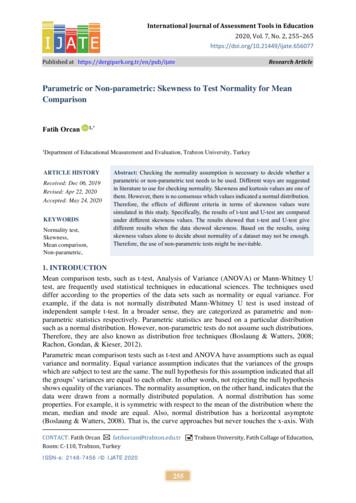CENTRAL MOMENTS, SKEWNESS AND KURTOSIS
CENTRAL MOMENTS,SKEWNESS ANDKURTOSISCentral Moments- The average of all thedeviations of all observations in a dataset from themean of the observations raised to the power r
In the previous equation, n is the number of observations, X isthe value of each individual observation, m is the arithmeticmean of the observations, and r is a positive integer.
Central (or Mean) MomentsIn mean moments, the deviations are taken from the mean.For Ungrouped Data:In General,r th Population Moment about Mean rr th Sample Moment about Mean mr x iN x x inrr
Central (or Mean) Moments Formula for Grouped Data:r th Population Moment about Mean r thr Sample Moment about Mean mr f xi ff x x firr
There are 4 central moments: The first central moment, r 1, is the sum of the difference of eachobservation from the sample average (arithmetic mean), whichalways equals 0 The second central moment, r 2, is variance.
The third central moment, r 3, is skewness.Skewness describes how the sample differs in shape from asymmetrical distribution.If a normal distribution has a skewness of 0, right skewed isgreater then 0 and left skewed is less than 0.
Negatively skewed distributions, skewed to theleft, occur when most of the scores are towardsthe left of the mode of the distribution.In a normal distribution where skewness is 0, themean, median and mode are equal.In a negatively skewed distribution, the mode median mean.
Positively skewed distributions occur when most of the scoresare towards the right of the mode of the distribution.In a positively skewed distribution, mode median mean.
SkewnessWhen the distribution is symmetric, the value of skewness should be zero.Karl Pearson defined coefficient of Skewness as:Mean ModeSDSince in some cases, Mode doesn’t exist, so using empirical relation,Sk Mode 3Median 2MeanWe can write,3 Median Mean Sk SD(it ranges b/w -3 to 3)
Kurtosis is the 4th central moment.This is the “peakedness” of a distribution.It measures the extent to which the data aredistributed in the tails versus the center of thedistributionThere are three types of peakedness.Leptokurtic- very peakedPlatykurtic – relatively flatMesokurtic – in between
Kurtosis Karl Pearson introduced the term Kurtosis (literally the amount ofhump) for the degree of peakedness or flatness of a unimodalfrequency curve.When the peak of a curve becomesrelatively high then that curve iscalled Leptokurtic.When the curve is flat-topped, thenit is called Platykurtic.Since normal curve is neither verypeaked nor very flat topped, so it istaken as a basis for comparison.The normalMesokurtic.curveiscalled
Kurtosis For a normal distribution, kurtosis is equal to 3. When is greater than 3, the curve is more sharply peakedand has narrower tails than the normal curve and is saidto be leptokurtic. When it is less than 3, the curve has a flatter top andrelatively wider tails than the normal curve and is said tobe platykurtic.
ExampleCalculate first four moments about the mean for the following set ofexamination marks: X 45 32 37 46 39 36 41 48 36
ExampleCalculate: first four moments about mean for thefollowing frequency distribution:Weights (grams)Frequency 4185-2045Total60
In a positively skewed distribution, mode median mean. Skewness When the distribution is symmetric, the value of skewness should be zero. Karl Pearson defined coefficient of Skewness as: Since in some cases, Mode
95% confidence interval of population skewness G1 2 SES I’m not so sure about that. Joanes and Gill point out that sample skewness is an unbiased estimator of population skewness for normal distributions, but not others. So I woul
Cornu's criterion tests the sample ratio of the mean deviation, e, to the standard deviation, a. The skewness and kurtosis test utilize respectively the moment coefficient of skewness, Yl, and the moment coefficient of kurtosis, Y2, in a Student's t test. Chauvenet's criterion tests the probability of occu
S&P 500 index options, we find that delta-hedged option gains decrease with ex ante volatility, in support of negative volatility risk premium. Moreover, the delta-hedged gains are negatively associated with skewness and kurtosis among call options, but positively associated with the higher moments among put options.
Non-parametric, Abstract: Checking the normality assumption is necessary to decide whether a parametric or non-parametric test needs to be used. Different ways are suggested in literature to use for checking normality. Skewness and kurtosis values are one of them. However, there is no consensus which values indicated a normal distribution.
tail moments k.X / Ck p. It is widely acknowledged that the “risk” is associated with higher moments of the loss distributions (e.g., “fat tails” are attributable to high kurtosis, etc). However, the HMCR measures are not the only coherent risk measures that quantify risk in terms of higher moments
empirical cumulative distribution functions, and additivity was evaluated with the different moments of the RT distribution (mean, variance, skewness, kurtosis). The results of these analyses indi-cated that the alternate-pathways model failed to successfully simulate
Method of Moments. Method of Moments. 1 2. Calculate low-order moments, as functions of θ Set up a system of equations setting the population moments (as functions of the parameters in step 1) equal to the sample moments, and derive expressions for the parameters as functions of the
The American Revolution had both long-term origins and short-term causes. In this section, we will look broadly at some of the long-term political, intellectual, cultural, and economic developments in the eigh-teenth century that set the context for the crisis of the 1760s and 1770s. Between the Glorious Revolution of 1688 and the middle of the eigh- teenth century, Britain had largely failed .






















